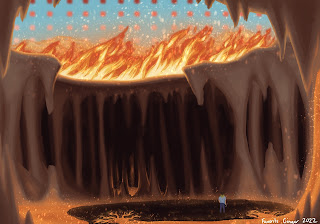Concluding Thougths

“Technique is only important insofar as you must master it in order to communicate what you see” My main goal this term was to grow my skill in order to more easily and effectively communicate what I wanted through my artwork. The first part of the term consisted of me figuring out how to better use some of the tools available to me to create art and messing around with more restricted color palettes, as well as working out how to draw people more easily, especially faces. Around the middle of the term, I veered sharply into creating lots of landscapes as well as eliminating linework from the art that I was doing. At the very end of the term these two skillsets kind of came together - my most recent artwork is a landscape that I made with a color palette consisting of 5 shades of blues and greens, and I’m quite happy with how it turned out. At the beginning of the term, I intended to redraw a piece of artwork in order to demonstrate how much I had grown my skills in the ten weeks ...





